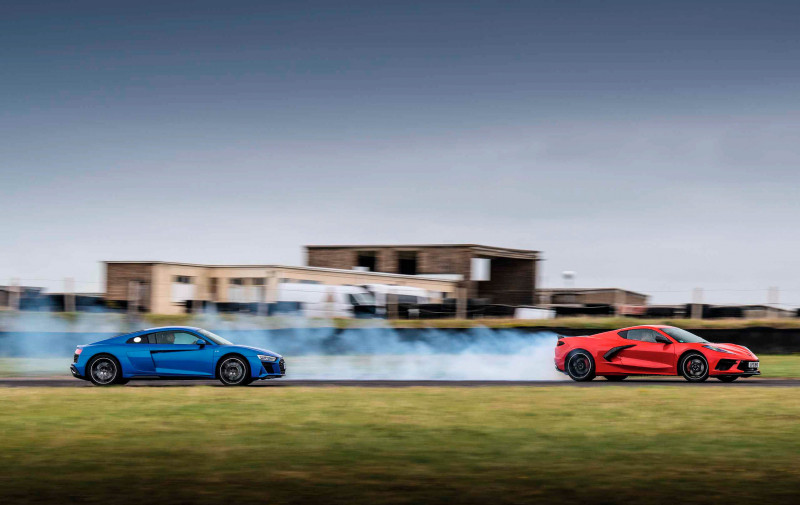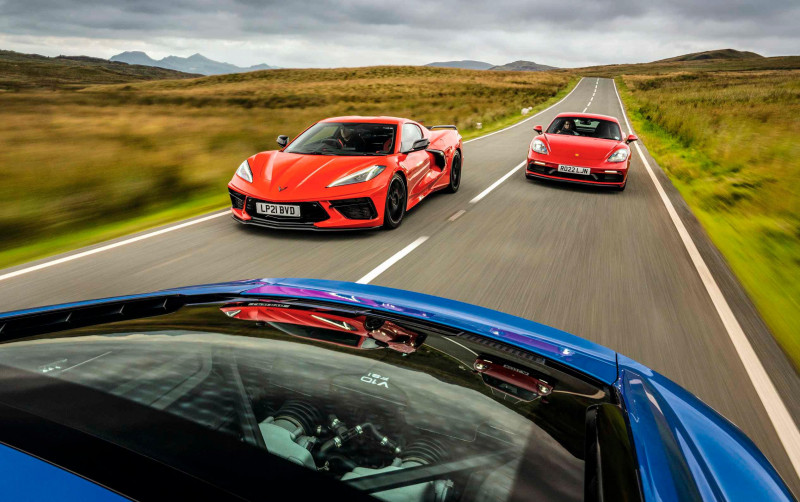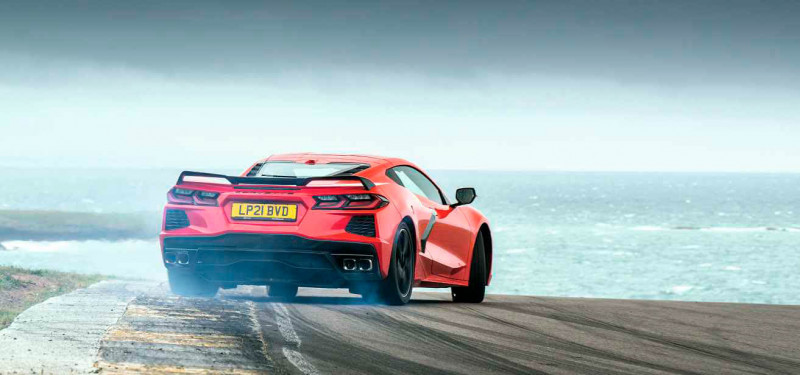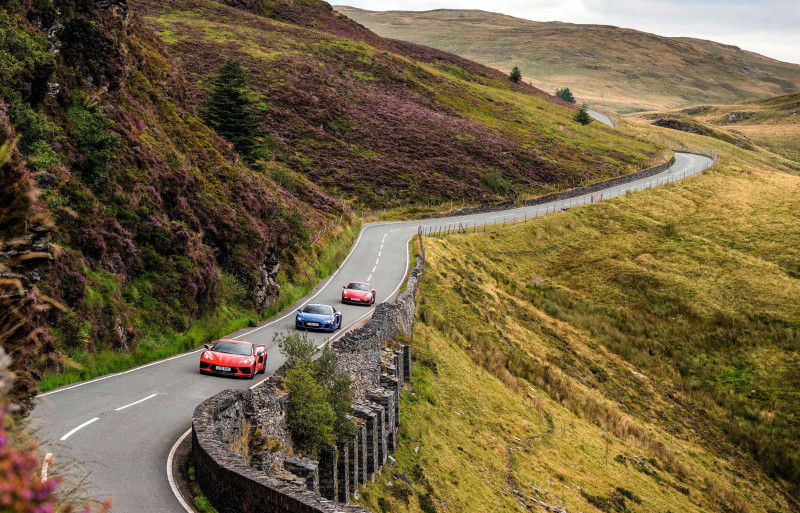2023 Chevrolet Corvette Stingray C8 vs. 2023 Audi R8 V10 Performance RWD Type 4S, 2023 Porsche 718 Cayman GTS 4.0 982C
Chevrolet’s first mid-engined Corvette C8 has landed in the UK, so we’ve put on a little welcoming committee from two of Europe’s biggest hitters: Audi’s R8 RWD Type 4S and Porsche’s Cayman GTS 982C.
WORDS by ADAM TOWLER
PHOTOGRAPHY by ASTON PARROTT
SPORTS CAR TEST
NO MIDDLE GROUNDCORVETTE STINGRAY v R8 RWD v CAYMAN GTS

Is the latest version of the American icon a supercar or a sports car? Adam Towler pitches it against benchmark examples of each to find out
The 562bhp R8 Performance RWD Type 4S may be the lowest rung in Audi’s ladder of mid-engined, ten-cylinder machines, but it’s a supercar alright. The ‘young entrepreneur’ types in the black-with-black-with-black current-shape RS6 knew it as they floored their V8 alongside with a dramatic bellow on the A55 to north Wales; the young lad with his nose pressed up against the smeary rear side-glass of an ageing Nissan Qashqai did too. Same for my neighbours, who congregated around it at the weekend, the point rather belligerently rammed home to them early this morning when Ingolstadt’s finest yelped into life on cold start and I selected Drive as quickly as I dared. It is low and wide, pointy and extravagant, loud, and it screams power and speed even if you don’t know the numbers, such as its £129,725 price tag, or the scope of its abilities. Supercar, I am.

However, this story isn’t really about the R8, but rather an opportunity to find out much more about a bright red American institution currently also making its way to north Wales – a car that over the past 20-or-so racing seasons has been a winner repeatedly on the world stage; a car that for this eighth generation GM decided to move the engine from the front to the middle. The company has also taken the unprecedented step of offering a right-hand-drive version, which while it’s typically British of us to assume has been done to make overtaking easier in the home counties, has a lot to do with selling the car in markets such as Australia and Japan as well.

So this is the new C8 Corvette Stingray, based on an aluminium tub, now screwed and bonded together and incorporating a strong backbone tunnel, powered by a mid- mounted LT2 small block V8 that produces 475bhp and 452lb ft of torque, and delivering drive through a Tremec-designed eight-speed twin-clutch transmission, the only ’box on offer. There are magnetic ride control adaptive coilovers at each corner and chunky Brembo brakes (part of the Z51 performance package that’s standard on UK cars and also includes a valved exhaust, enhanced cooling, a shorter final drive ratio and additional brake cooling). There’s also the longest list of standard equipment you’re ever likely to see, plus a truly bewildering list of colour and trim options (12 of the former, six combinations for the latter). You can have it in either coupe form as here, or as a convertible, but all coupe’s actually have a lift-out ‘Targa’-style roof panel anyway, so you always have the option of open-air motoring. Do me one favour, though: if you haven’t looked up the price of a Stingray in the UK, don’t just yet. Save that for later.

If the Vette turns out not to be a supercar, then what sort of sports coupe is it? To judge that, we’ve brought along one of our favourites – of now and of any time – the Porsche Cayman GTS 4.0, whose wonderful chassis and sonorous and bespoke flat-six are worth the £68,700 price of admission alone. Hopefully after a day on some great roads, plus a further day on Anglesey Circuit, we should have a particularly thorough answer.
I’m not sure quite what to expect from the R8. We had one in briefly for a first drive and its passive damper set-up didn’t elicit much praise. This example also has the standardfit springs and dampers (only the quattro models get DRC as standard), but a glance at the ever-so-slightly undernourished rims in the arches betrays the fact that car is running the standard 19-inch wheels, as opposed to the 20-inch rims of that previous example; maybe that’ll make a difference.
That said, first impressions of the R8 centre on the engine and the interior ambience. You simply can’t avoid the V10, because it’s a thread that runs through the entire R8 experience, a constant, pulsive presence that can always elicit that stomach-flip of excitement. As for the interior, the inherent thrill of sitting inside something so low and wide should never be underestimated, but where you might expect a supercar to be about extravagance, opulence or track-biased purpose, the R8 RWD appears to channel its inner Clark Kent, hiding its 10-cylinder exoticism behind a facade that wouldn’t be out of place in a mid-spec A3. The lack of a central screen means the digital dial pack is overly busy and, while I’m having a gripe, it’s rather bizarre that a car like the R8 should have to make do with the VW Group’s miniature gearchange paddles, which are inadequate in a Polo GTI, let alone a car such as this one.
A wet and windy M6 isn’t the most glamorous of beginnings, but the R8 aces it all the same, although as previous experience attests, there’s something about the slightly upright driving position that makes various joints and muscles of mine ache after a couple of hours. You can certainly feel the lack of those adaptive dampers, for the ride quality at lower speeds stays only just the right side of jiggly, slightly at odds with the rest of the demure R8 experience. I’d wager it’s the smaller rims that help to keep it tolerable and, once you’re over 40mph, the ride smooths out into a more relaxing gait.
Yet it’s only when we reach some of our favourite routes in the mountains that I get to experience what makes the R8 special. If the car feels rather firm at low speed, then the compromise now is one of softness, but it’s one I don’t mind at all, the gentle body-roll and pitch communicating what’s happening and separating each corner of the car out so you have a sense of grip levels and weight transfer – something you don’t really get from the steering, which is precise but hardly dripping with feedback. When you really lean on it, the R8 certainly shows its class.
So to the Corvette. Immediately, I’m struck by its size, for it is much bigger than I’d imagined and certainly wider, very much the full-fat supercar in terms of road presence. And while we never like to dwell on matters of style at evo – it’s personal taste, after all – to be blunt, all of us are struck by just how ungainly the C8 looks from some angles, something not helped by the black wheels and a track that doesn’t quite fill out the arches. There’s a naivety to it, especially when viewed from the rear; its blocky, eight-bit form and retrowave style wouldn’t be out of place in that classic arcade game, OutRun, although for that reason alone I can’t help but be drawn to it!
But here’s the thing: for all of our wry giggles at its expense, it’s the Vette that gets the attention; the Vette that draws the oohs and ahhs from the general population, not so much the R8. The fundamental truth is that, with very few exceptions, people love the Corvette and think it looks absolutely brilliant. Everywhere it goes it draws a crowd, and I lose track of the number of occasions when onlookers mistake it for the latest Ferrari, or prophesise that it must cost at least £200,000 (hint: it isn’t). It’s a genuine A-lister celebrity, and no doubt delights in proving our amateur aesthetic judgements wrong at every opportunity.
That larger-than-life personality is continued on the inside, for the C8 eschews the Audi’s sensibleness for maximum drama, this particular car mixing swathes of red and black leather with carbonfibre, aluminium and plastic-chrome into a heavily driver-focused cockpit with an arching spar festooned with switchgear in a singular, long thread and an Alcantara-clad quartic-shape steering wheel. Over your shoulder and glimpsed in the rear view mirror lies that V8, exposed in its cradle for all to see just like the Audi’s V10, or you can switch the rear view mirror to the camera and get an improved view of the road aft. By comparison, the Porsche’s sleek, practical, familiar interior can’t help but feel somewhat pedestrian, albeit unerringly solid.
The Corvette’s scuttle is low, giving an expansive view of the road ahead and the impression of sitting at the forefront of a powerful dart, and the laid-back seating angle (with the superb optional bucket seats) means it has a driving position that’s the equal of the Porsche’s and arguably more racy with it. Wake the V8 and its deep resonant burble is surprisingly civilised, although there’s more of an industrial thump on the outside, more in line with expectations for a traditional American V8.
By now you won’t be at all surprised to hear that the C8 offers a lot of driver modes: there’s Weather, Tour, Sport and Track, plus a ‘MyMode’ (user-configurable) and a Z mode (as per MyMode but with additional adjustments for engine and gearbox). I start by shuffling through all of them, but rapidly settle on Tour for the mundane stuff and the usual evo road tester’s recipe of a Z mode set to awakened engine and ’box but with medium ride comfort.
Again, as you might expect of a car designed to cover big mileages in its sleepy setting, it’s a comfortable and almost effortless way to knock back miles. The ride has a soft edge that deals well with ravaged Welsh surfaces, only occasionally feeling almost a little too loose, though most of this is actually suspension noise rather than any inability to deal with an intrusion or particular bump. The steering is immediately alert just off dead centre, and from then on it feels like a fast ratio, small inputs encouraging the car’s nose to dive dramatically for the apex with a strong impression of unimpeachable front-end grip – so much so that initially it’s easy to be too aggressive with your inputs before you’ve adapted to it.
In some ways, and surprisingly, the least spectacular part of the package is the engine. There’s plenty of volume when you’ve selected an angrier setting, but it’s not quite the muscle-bound, snargly roar you might have been hoping for, and there’s never a sense of it really winding up and troubling the limiter. Then again, common sense suggests, why would it? In true stock-block fashion, the V8 is all about getting on with business, and it does that from just a few thousand rpm and onwards in a solid band of useful thrust, punctuated by rapid shifts elicited via a fine pair of paddles either side of the wheel. You soon realise it’s a very effective partner for piling on speed.
After the bright, brash, alien world of the Vette, the Cayman is a much more lithe and biddable machine with which to negotiate this familiar territory of fast sweepers and occasional tight corners. It musters 394bhp and 310lb ft of torque, which in a car that weighs just over 1400kg in manual form as tested here (1405kg to be precise; the Vette comes in 250kg more) equates to a vibrant and decidedly intimate machine. There’s a glossy veneer of polish to how every control carries out its function, and moreover their relationship with each other, that the Vette can’t quite match and the Audi misses by its ultimate lack of attention to the details (the irritating kickdown function, tiny paddles and hesitant ’box in auto mode being some of them). The Porsche is virtually flawless in many ways, and without much in the way of initiation you find yourself dispatching sections of road with real determination and pace. The Cayman doesn’t need a warm-up: you just get in and go for it.
There are, however, a few areas where it must inevitably give best to its rivals here, presence being one of them. It might seem harsh to criticise a sports car for not competing with a supercar in this regard – that’s not what it’s here for. Even so, Carmine Red when dirty, teamed with black wheels, does nothing for the car’s appeal on a cloudy Welsh hillside in this company. That same ease of use and the progressiveness of the controls could be perceived by some as almost making the Cayman too easy. I’m not sure I fully subscribe to this view, but I suspect that if your personal preference is for a car to be more of a challenge (is this saying ‘not as good’, I wonder?) or to have a more predetermined handling characteristic (for example, a powerful front-engine/ rear-drive car’s propensity to oversteer) you might find the Cayman’s benign response almost, and for want of a better word, sanitised. The counterpoint states that the way the GTS scythes along a difficult road makes it anything but.
The gearing, however, is harder to excuse. I know: this is becoming like Porsche bingo, so many times have we said it before, yet the more I drive the GTS, the more the long ratios undermine the appeal of a fabulous engine, reducing it to lugging almost exclusively in second gear on a B-road and thereby blunting its accelerative edge and removing in many cases the reason for choosing a manual gearbox in the first place, i.e. the act of physically changing gear with a lever and a clutch pedal.
I’m back in the Vette now and it does feel a bit unwieldy after the Porsche. Some big cars have a knack of shrinking around you, but despite the C8’s fast steering and agility it doesn’t quite manage this, perhaps just a tiny reminder that its roots lie a few thousand miles west of these evo favourites. Even so, feeling snug in my heated seat and with the soft rumble of the small block flexing its muscles behind my head, making progress to our overnight near Anglesey Circuit is a relaxed and enjoyable experience. I miss the velvety backbeat of the R8, but not a lot else.
It just about stays dry for our time on track, long enough for the Corvette to rip around in the hands of Steve Sutcliffe in 1:15.6 (look out for the forthcoming evo YouTube vid). To put that in some context, it’s only a second off the pace of a Nismo GT-R, nearly half a second quicker than a 992 Carrera S, and around three seconds faster for the lap than a Lotus Emira V6 (yes, the Emira was on the road tyre option, but then the Corvette’s Michelin Pilot Sport 4 S tyres are hardly semi-slicks, and we had no fresh tyres to play with on the day, only the tyres the Vette came on for the test). In short, it’s a stunning performance.
From behind the wheel, it defies expectations: it grips and goes rather than playing the hooligan, and you have to try very hard to deliberately slide it around if you find yourself with a photographer pointing his lens at you and asking for something smoky. I find the steering weight too stodgy in Track, so ratchet it back to a lighter setting, but I can never get my head around the oddly shaped steering wheel, which works fine up until the point the car loses traction at the rear, and then feels completely weird if you have to wind on some opposite lock. Round steering wheels, huh? Who’d have thought they’d work so well…
The Audi, meanwhile, really enjoys stretching its legs, but there’s a strong and predictable safety net of understeer to contend with and, when it does oversteer, particularly when it begins to rain, you need to be on top of your game to gather it up, such is the momentum of the V10 over your shoulder. The Cayman is less threatening, even on a wet track, and falls into oversteer easily with only a little provocation under braking – the opposite of the C8. But the gearing still grates: one moment it feels gutless, or conversely you’re hanging onto a gear through necessity and it’s running out of puff. Perhaps a PDK-equipped car would have been preferable and a better match for the other two. What would normally be a plus-point in having a manual turns into a frustration with the GTS.
My drive home is in the R8, and after hours of motorway tedium the last miles are on country roads I know well, drenched in late summer sun; an evening with those long shadows and a drowsy vibe that suggests another autumn is just around the corner. Taking manual control of the R8’s gearbox, I let the V10 sing down the straights and coast gently into long, open corners, with both side windows down to better hear the symphony being released from the exhausts. It’s a calm but swift sort of drive, and one that’ll live on in my mind for months, if not years. That, beyond its kerbside appeal, is what makes the R8 a proper supercar: the ability to deliver those golden moments that transcend mere driving.
The Cayman can’t deliver those, of course, but it remains a desirable car. Yet as we found in eCoty 2020, there’s just something maddeningly, intangibly missing, that means it falls just short of the lofty expectation we have for it. The jump in appeal to a GT4 is larger than it looks on paper, and the gearing really is a major issue for this manual version. Conversely the GTS would make for an effortlessly rewarding ‘daily’; I just don’t desire it with quite the fervour its specification suggests I should. And so to the Corvette. Is it a supercar? No, not quite, because in the final reckoning it can’t quite deliver the sort of moments of inspiration that occasionally occur in the R8, but the bigger surprise is just how close it gets. It is a car of contradictions: on one hand it’s a predictably larger-than-life character, but to stereotype it as such is to misrepresent it. This is no crude muscle car – it’s a sophisticated, entirely modern machine, with huge performance on road and track, and one that to most people certainly looks the part.
It is also, emphatically, amazingly good value. Remember I said not to look up the price? Well, you can have a Corvette Coupe in the UK for £79,300, which makes it a genuine bargain. Or put another way, almost a supercar for sports coupe money. Finally, after eight generations, the Corvette in Europe just got very serious indeed.
TECHNICAL DATA 2023 Porsche 718 Cayman GTS 4.0 982
- Engine Flat-six, 3995cc
- Max Power 394bhp @ 7000rpm
- Max Torque 310lb ft @ 5000rpm
- Weight 1405kg
- Power-to-weight 285bhp/ton
- 0-62mph 4.5sec
- Top speed 182mph
- Basic price £68,700
- DrivesToday rating 4/5
TECHNICAL DATA2023 Audi R8 V10 Performance RWDType 4S
- Engine V10, 5204cc
- Max Power 562bhp @ 7800rpm
- Max Torque 406lb ft @ 6400rpm
- Weight 1595kg
- Power-to-weight 358bhp/ton
- 0-62mph 3.7sec
- Top speed 204mph
- Basic price £129,725
- DrivesToday rating 5/5
TECHNICAL DATA 2023 Chevrolet Corvette Stingray C8
- Engine V8, 6162cc
- Max Power 475bhp @ 6450rpm
- Max Torque 452lb ft @ 4500rpm
- Weight 1655kg
- Power-to-weight 292bhp/ton
- 0-62mph 3.5sec
- Top speed 184mph
- Basic price £79,300
- DrivesToday rating 4/5
Opposite, top: Corvette driving position is terrific – not quite so successful is the quartic steering wheel. Left: V8 Vette has an 81bhp advantage on the six-cylinder Cayman.
‘THE CORVETTE IS VERY MUCH THE FULL-FAT SUPERCAR IN TERMS OF ROAD PRESENCE’
Above: R8 and Cayman will provide a stern test for the C8 Corvette (above right) on these roads. Right: RWD version of R8 has passive dampers, unlike quattro.
‘THE R8’S V10 CAN ALWAYS ELICIT THAT STOMACH-FLIP OF EXCITEMENT’


